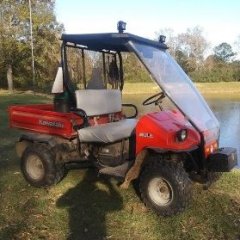Ol' Reliable ain't charging
-
Similar Topics
-
By GunnersTacklebox
Hi All,
New here, but bought a 2022 Sector 750 brand new last march (old stock up here in Canada)
It's a good bike so far, but I have noticed a quirk and was wondering if anyone else has had a similar issue?
The issue I've had is if I leave the utv parked on any incline, not even a major incline, and leave it to sit for a while (day or two) it will not start properly. It will turn over and not fire until I press the gas pedal, when it will run and rev up, but if I let off the gas it will die. It will keep doing this until I either start it in gear and drive it for a bit or leave it in neutral and roll it down the hill to flatter ground. where it will have to sit for a while.
If I park it on a decline there is no issue. fuel is not low, it's occurred a couple times now.
Any thoughts on the cause of this? Dealership just says bring it in and let them take a look, at my expense of course.
-
By didgeridoo
Hello, All! I've decided to replace the traction batteries in my 2018 Sector E1 with a 48V Lithium set. They may be expensive, but I figure the Discovery Dry Cell are, too. I am not looking for the max driving range, as I have never received near the brochured range to begin with, but a good mix of charge/ get work done/ charge is what I am expecting.
I have settled on the 48V EAGL kit from bigbattery dot com. Each battery pack provides 30Ah. The kit ships with a charger, as well. The packs would be physically connected in parallel (using a busbar) to one another, maintaining the 48V voltage, but together would be able to provide the amp draw the buggy pulls when going up hill or towing a rake (rated 320 max continuous Amps). This is in comparison to the serial connection the eight 6V lead batteries. Each of the EAGL batteries looks to have its own BMS; am I correct in thinking I will have to use their included charger rather than (simply) changing the onboard charger to lithium mode? The chemistry of the pack is LiFe PO4, for what it's worth. I haven't torn anything apart yet (to diagram), so I am not sure how the dash will interpret the AMP draw, but the kit I am looking at includes a dash mounted charge indicator.
If anyone has completed a similar conversion, do you have any tips? Specifically, how did you remove the original batteries, and how did you secure the new ones? I am guessing that almost any change from the stock batteries would involve at least some modifications. Any tips would be appreciated, especially things I may have failed to consider. Thanks!
-
By Homeowner A
I was randomly and briefly able to connect to my Coleman UTV 400s ECU the other day twice and haven't been able to since. When I was able to access it, I found the following codes and wondered if anyone may know where I should start or what I should look at?
P0031 - O2 Sensor Heater Control Voltage Low
P0107 - Manifold Absolute Pressure/Barometer Pressure Voltage Low
P0113 - Intake Air Temperature Sensor Voltage High
P0118 - Engine Coolant Temperature Sensor Voltage High
P0650 - Malfunction Indicator Lamp (MIL) failure
-
By Gorj
I am going to replace the batteries in my E1. I am not interested in the high cost Lithium or the expensive 6 volt dry batteries. I am considering four 12 volt deep charge marine batteries. I have a source for 810 amp units for about $100 each. I have no worries about reprograming the charger because it went out a few years ago and I replaced it with generic golf cart charger. When I decide to do this, I'll keep you posted on the results.
-
-
By Alien10
I'm thinking of buying a snow blade for my Coleman Outfitter 550 (Hisun with Coleman stickers).
Has anyone purchased a snow blade that can offer the make and model they bought and any comments, pros cons etc.?
Not 100% sure I'm going to buy, as the selection of blades for this model seems a bit thin on line.
Thoughts and comments welcomed.
Thanks in advance.
-









Recommended Posts
Join the conversation
You can post now and register later. If you have an account, sign in now to post with your account.
Note: Your post will require moderator approval before it will be visible.